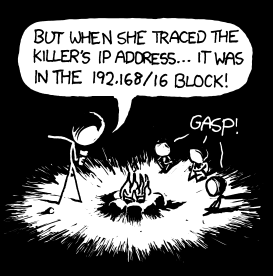742: Campfire
| Campfire |
 Title text: 100 years later, this story remains terrifying--not because it's the local network block, but because the killer is on IPv4. |
Explanation
Cueball is telling a scary story to kids by the campfire about a killer. It seems as if the main character was able to trace the killer's computer to a local address (most likely one in her own house). 192.168/16 refers to the subnet the computer is on. The 192.168/16 subnet is reserved for private networks and traffic to or from addresses on that subnet and will not be routed by most internet-facing routers. Most home networks that are behind a router usually have addresses such as 192.168.0.xx or 192.168.1.xx and use NAT to present different addresses to the rest of the internet. This is a modern update of a similar actual scary story (most famously seen in the film When a Stranger Calls, where the victim attempts to find the source of threatening phone calls only to find that they are coming from inside the house
The title text claims that this is scary as the killer is on IPv4. Currently the number of available IPv4 addresses are dwindling. There are plans to replace the addresses with IPv6, which will largely increase the number of available addresses. In 100 years it would be very (technologically) scary for someone to still be using IPv4. This would be analogous to receiving a message by telegram today, rather than as an email or text.
Cueball's story is likely based on the horror movie When a Stranger Calls (released in 1979, and re-made in 2006) or another version of the legend the movie was based on. All have a similar basic plot: the killer calls the victim at home; when traced, the call is coming from a phone inside the victim's home.
Transcript
- [Cueball and three children are around a campfire at night. Cueball is standing up, with a flashlight under his face.]
- Cueball: But when she traced the killer's IP address... it was in the 192.168/16 block!
- Children: Gasp!
Discussion
"100 years later, this story remains terrifying--not because it's the local network block, but because the killer is on IPv4."
It already is.
172.69.69.28 13:20, 27 October 2018 (UTC)
- Says a person signing with IPv4 address. 162.158.88.105 14:19, 6 October 2021 (UTC)
- Says a person signing with IPv4 address. Me[citation needed] 05:18, 9 October 2024 (UTC)
There is a mistake in the transcription of the title text at the top of the page. It should say 'the killer is still on IPv4', not just 'the killer is on IPv4'. I don't know how to correct it. 141.101.98.12 14:46, 18 December 2023 (UTC)
- You do it by... doing what I just did do. (Hoping that the 'bot that protects against vandalism doesn't revert my IP-only change.) Good catch.
- I wonder if that was an error by the original page-creator? If it had been one or other of the auto-creating 'bots that we've had doing this thing then it would be a sign of post-copied editing, but I'd have to poke around in external archives to be sure if it was misread by that person or messed about with by Randall after the fact. (If it turns out to have been, then maybe worth a note about it. Albeit that maybe this conversation is enough of a note.) 172.71.178.77 16:49, 18 December 2023 (UTC)
You guys talk big for guys without IPv6 162.158.95.136 (talk) 08:51, 21 January 2024 (please sign your comments with ~~~~)
